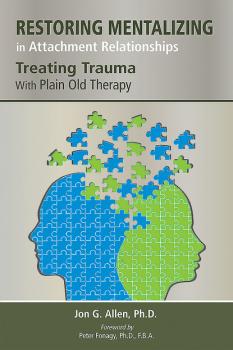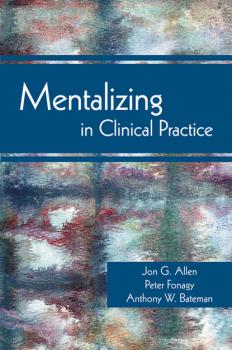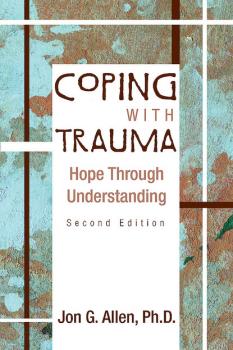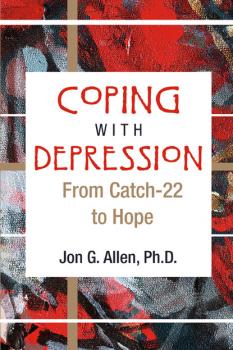ТОП просматриваемых книг сайта:
Jon G. Allen
Список книг автора Jon G. AllenАннотация
In Restoring Mentalizing in Attachment Relationships: Treating Trauma With Plain Old Therapy, Jon G. Allen, Ph.D., argues that the incorporation of mentalizing into attachment theory and research provides a solid foundation for trauma treatment, and offers therapists and patients a pathway to recovery. In plain language accessible to clinicians and laypeople alike, Allen describes trauma in attachment relationships, reviews the literature, and makes a compelling, evidence-based argument for the efficacy of psychotherapy. Specifically, the book: Presents a comprehensive view of attachment trauma across diverse diagnostic conditions, directly linking these to the psychotherapeutic interventions that work best. Allows therapists from different theoretical frameworks, by using these best practices, to treat patients with a wide range of problems and disorders. Situates mindfulness and mentalizing as central to secure attachment, focusing clinicians' attention on these most critical dimensions of healing relationships. Provides a thorough review of the research on attachment, mindfulness, and mentalizing, and evaluates the effectiveness of the most popular trauma treatments, thereby equipping clinicians to treat patients across the spectrum of trauma-related psychiatric disorders. Employs a down-to-earth, conversational writing style that makes the book accessible to patients and family members as well as to professionals. Trauma can be the result of blatant events, such as violence, abuse, and neglect, or the subtle yet pervasive failure to connect. Both contribute to developmental psychopathology and cause lasting emotional pain. «Plain old therapy,» according to Allen, is a valuable and proven resource for addressing trauma and treating patients with complex psychiatric disorders. This fascinating and eminently useful book should help to restore psychotherapy to its well-deserved stature.
Аннотация
Mentalizing, the fundamental human capacity to understand behavior in relation to mental states such as thoughts and feelings, is the basis of healthy relationships and self-awareness. A growing evidence base supports the effectiveness of mentalizing-focused interventions in the treatment of borderline personality disorder. This volume explores wider applications, construing mentalizing as a core common factor in the effectiveness of psychotherapeutic interventions that cuts across treatment modalities and theoretical approaches ranging from psychodynamic to interpersonal and cognitive therapies.This book distills the burgeoning literature on mentalizing for clinicians of diverse professional backgrounds. The book is divided into two parts: Understanding Mentalizing fully explicates the concept of mentalizing and its foundations in developmental research and social-cognitive neuroscience; Practicing Mentalizing presents the general principles of psychotherapeutic interventions that promote mentalizing as well as a range of current clinical applications. Mentalizing is multifaceted – for example, pertaining to self and others as well as explicit and implicit processes – and links to myriad overlapping concepts including empathy, metacognition, theory of mind, mindfulness, and psychological mindedness. Two sides of research on the development of mentalizing in attachment relationships have significant clinical implications: interactions in secure attachment relationships enhance mentalizing and illuminate the conditions of optimal psychotherapeutic relationships; conversely, trauma in attachment relationships undermines the development of mentalizing and eventuates in developmental psychopathology that poses special challenges for psychotherapy. Neuroimaging is illuminating diverse brain regions that contribute to mentalizing capacity, including a «mentalizing region» in the medial prefrontal cortex that is consistently activated in mentalizing tasks; concomitantly, research on autism and psychopathy attests to the neurobiological basis of psychopathologies in which stable impairments of mentalizing are most conspicuous. In development and in psychotherapy, mentalizing begets mentalizing, as exemplified by a mentalizing stance that fosters inquisitiveness and curiosity about mental states in oneself and others; basic principles and clinical examples, including the use of transference, demonstrate the spirit and technique of mentalizing, capped off by a patient's first-hand account of mentalization-based treatment for borderline personality disorder. Attachment trauma is the wellspring of disrupted mentalizing capacity, and a focus on mentalizing provides an integrative framework for psychodynamic and cognitive-behavioral treatment of trauma as well as for parenting, family, and social-systems interventions directed toward interrupting the perpetuation of trauma in relationships. Psychoeducational interventions, including patient education and structured exercises, are employed to cultivate a therapeutic alliance around mentalizing; the book includes a straightforward explanation clinicians can use with patients, «What is Mentalizing and Why Do It?» In the chapter on mentalizing interventions, the authors propose to clinicians, «You are already doing it.» If the effectiveness of treatment depends on therapists mentalizing and helping their patients do so more consistently and skillfully, clinicians of all persuasions can benefit from the extensive knowledge now available to hone further their attention to this vital therapeutic process.
Аннотация
Combining years of research, teaching, and experience treating trauma survivors, Dr. Jon G. Allen offers compassionate and practical guidance to understanding trauma and its effects on the self and relationships. Coping With Trauma is based on more than a decade of Dr. Allen's experience conducting educational groups for persons struggling with psychiatric disorders stemming from trauma. Written for a general audience, this book does not require a background in psychology. Readers will gain essential knowledge to embark on the process of healing from the complex wounds of trauma, along with a guide to current treatment approaches.In this supportive and informative work, readers will be introduced to and encouraged in the process of healing by an author who is both witness and guide. This clearly written, insightful book not only teaches clinicians about trauma but also, equally important, teaches clinicians how to educate their patients about trauma.Reshaped by recent developments in attachment theory, including the importance of cumulative stress over a lifetime, this compelling work retains the author's initial focus on attachment as he looks at trauma from two perspectives. From the psychological perspective, the author discusses the impact of trauma on emotion, memory, the self, and relationships, incorporating research from neuroscience to argue that trauma is a physical illness. From the psychiatric perspective, the author discusses various trauma-related disorders and symptoms: depression, posttraumatic stress disorder, and dissociative disorders, along with a range of self-destructive behaviors to which trauma can make a contribution.Important updates include substantive and practical information on Emotion and emotion regulation, prompted by extensive contemporary research on emotion – which is becoming a science unto itself. Illness, based on current developments in the neurobiological understanding of trauma. Depression, a pervasive trauma-related problem that poses a number of catch-22s for recovery. Various forms of self-destructiveness – substance abuse, eating disorders, and deliberate self-harm – all construed as coping strategies that backfire. Suicidal states and self-defeating aspects of personality disorders. The author addresses the challenges of healing by reviewing strategies of emotion regulation as well as a wide range of sound treatment approaches. He concludes with a new chapter on the foundation of all healing: maintaining hope.This exceptionally comprehensive overview of a wide range of traumatic experiences, written in nontechnical language with extensive references to both classic and contemporary theoretical, clinical, and research literature, offers a uniquely useful guide for victims of trauma, their family members, and mental health care professionals alike.
Аннотация
Distilling years of experience in educating psychiatric patients and their families about depression, Jon Allen has written a practical book that addresses the challenges depressed patients face on the road to recovery. Allen advocates approaching depression by focusing on the importance of hope, and he helps patients understand depression through two simple ideas: catch-22 and stress pileup. This book conveys how the symptoms of depression impede all the things depressed persons must do to recover, thus defusing self-criticism while encouraging patients to take satisfaction in small steps toward improvement. And the concept of stress pileup encompasses a developmental perspective respecting the full range of accumulated biological, psychological, and interpersonal stresses that play into depression. This broad understanding helps patients become more compassionate toward themselves and puts them in a stronger position to make use of professional care.Coping With Depression is written for a general audience, including depressed persons and their family members, as well as professionals seeking a readable integration of current knowledge that they can use to educate their patients. Although written in nontechnical language, the book provides a sophisticated and comprehensive understanding of the psychological development of depression, the neurobiology of the illness, and the full range of evidence-based treatment modalities. All material is buttressed by extensive references to theoretical, clinical, and research literature.Coping With Depression emphasizes the concept of agency, encouraging readers to take an active role in their recovery. Countering today's trend toward exclusive reliance on antidepressant medication, the book employs the perspective of developmental psychopathology to integrate psychosocial and neurobiological knowledge. The book explains how biological vulnerability is intertwined with stress stemming from insecure attachment, childhood adversity, stressful life events, emotional conflicts, and problems in close relationships. Going far beyond the «chemical imbalance,» the author illustrates how the experience of depression is linked to changes in patterns of brain activity as evidenced by neuroimaging studies. Coping With Depression will help readers understand the development of depression from a biopsychosocial perspective appreciate how depression is compounded by related conditions, including bipolar disorder, anxiety disorders, substance abuse, personality disorders, general medical conditions, and suicidal states understand how recovering from depression entails working on many fronts, including improving physical health, participating in pleasurable activities, countering negative thinking, resolving internal conflicts, and-above all-establishing more stable and secure attachment relationships become knowledgeable about the treatment options that facilitate coping, including cognitive-behavioral, interpersonal, and psychodynamic psychotherapy as well as medication and combined treatment appreciate the centrality of hope in recovery from depression and the challenges to hope that depression poses To maintain hope, patients, their family members, and clinicians must face the seriousness of the illness of depression and the daunting obstacles to recovery, including catch-22 in all of its manifestations. Throughout the book, Allen reiterates the theme of agency: depressed persons can use their intelligence to understand their illness and do something to recover and remain well, making use of help from others along the way.




